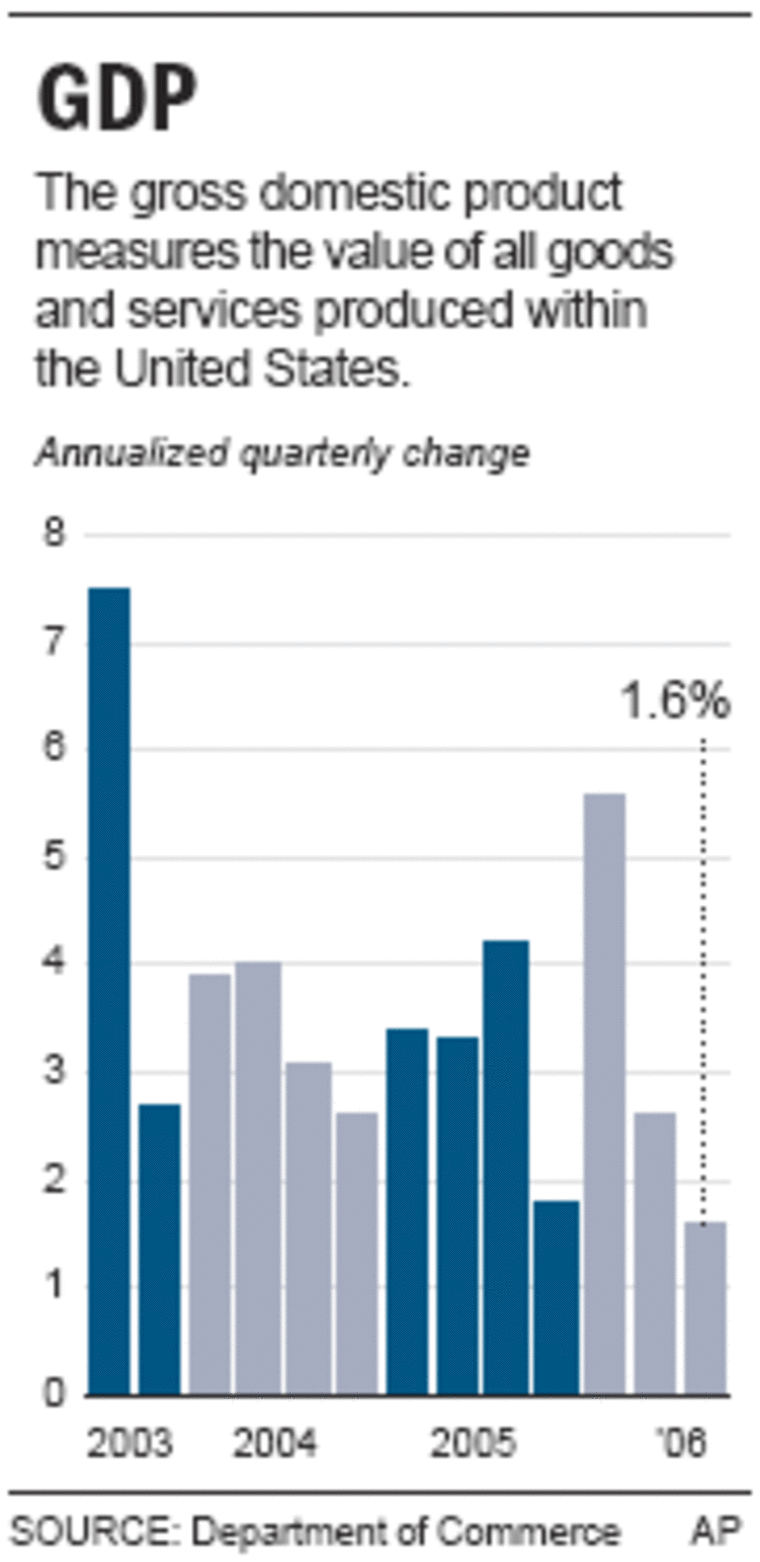Economic growth slowed to a crawl in the third quarter, advancing at a pace of just 1.6 percent, the worst in more than three years.
The latest snapshot of the economy, released by the Commerce Department on Friday, showed that the slumping housing market figured prominently in the economy’s dramatic loss of momentum. Investment in homebuilding was cut by the biggest amount since early 1991.
The reading on gross domestic product was weaker than the 2.1 percent pace many economists were forecasting.
“The housing bubble burst and that really knocked down growth,” said Joel Naroff, president of Naroff Economic Advisors.
Gross domestic product measures the value of all goods and services produced within the United States and is considered the best barometer of the country’s economic standing. Friday’s report provided the last GDP reading before the Nov. 7 elections.

Economic matters are expected to influence voters’ choices when they go to the polls. President Bush’s approval rating on the economy is at 40 percent, among all adults surveyed in an AP-Ipsos poll. That remains near his lowest ratings. Those surveyed trusted Democrats more than Republicans to handle the economy.
The White House said it was not worried about the slowdown in economic growth.
“Everybody expected this. You have a combination of rising energy prices and also rising interest rates, and now you’ve seen a reverse on both,” said White House press secretary Tony Snow.
Commerce Secretary Carlos Gutierrez said that latest GDP figures displayed the economy’s resilience even as the housing market has tanked. “I would not panic about this,” he said in an interview with The Associated Press.
The third quarter’s 1.6 percent growth rate was the weakest since the first quarter of 2003, when the economy grew at a 1.2 percent annual rate.
The latest performance underscores just how much speed the economy has lost this year.
In the opening quarter, the economy grew at a brisk 5.6 percent pace, the strongest growth spurt in 2 1/2 years. But growth slowed to a 2.6 percent pace in the second quarter as consumers and businesses tightened the belt in response to the toll of rising energy prices and the impact of two-plus years of rising borrowing costs.
In the third quarter, consumers held up well, though. They boosted their spending at a rate of 3.1 percent, up from a 2.6 percent pace in the second quarter.
Businesses, meanwhile, increased spending on equipment and software at a 6.4 percent pace in the third quarter, an improvement from the 1.4 percent rate of decline in the second period.
Economists took heart that consumers and businesses — outside of the residential sector— spent solidly — which helped to cushion some of the fallout from the housing slump.
The economy’s softness in the third quarter stemmed in large part from the cool down in the once-hot housing market.
Spending on home building dropped at a rate of 17.4 percent in the third quarter. That was the biggest drop since the first quarter of 1991 when such spending was sliced at a 21.7 percent pace.
Weak inventory building by businesses and the bloated trade deficit also played roles in weighing down economic activity in the third quarter.
Even with the feeble third-quarter showing, analysts didn’t believe the economy was in danger of sliding into recession.
An inflation gauge tied to the GDP report showed that core prices — excluding food and energy — advanced at a rate of 2.3 percent in the third quarter, which was down from 2.7 percent in the second quarter.
Over the last 12 months, however, this inflation measure rose by 2.4 percent, the largest annual increase since 1995.
Energy prices, which had surged in the summer, have since calmed down.
Gas prices are now hovering around $2.23 a gallon nationwide, compared with more than $3 a gallon in early summer. Oil prices are now just over $61 a barrel, down from $77.03, a record high close in mid-July.
That is supposed to help ease inflation and lead to better economic activity.
Lower energy prices leave people and companies with more money to spend on other things. If they spend and invest, that adds to economic growth. Many economists believe the economy will do better in the current October-to-December quarter, perhaps clocking in close to 3 percent.
The Federal Reserve held interest rates steady on Wednesday for the third meeting in a row. The Fed had hoisted rates 17 times since June 2004 to fend off inflation. The Fed’s goal is to slow the economy sufficiently to thwart inflation but not so much that it tips into recession.